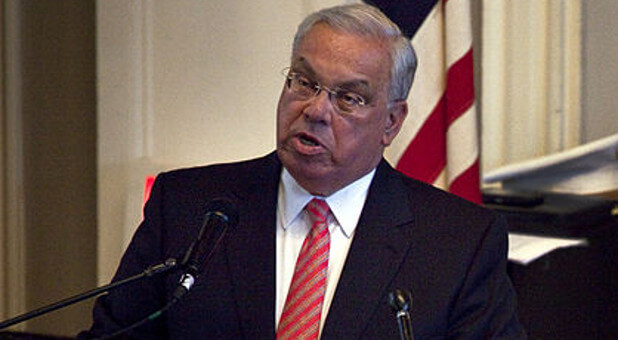With flu cases in Boston up tenfold from last year, the city’s mayor declared a public health emergency Jan. 9 as authorities around the United States scrambled to cope with a rising number of patients.
U.S. health authorities say the flu arrived about a month earlier than usual this year, and the flu strain making most people sick—H3N2—has a reputation for causing fairly severe illness, especially in the elderly.
As a result, hospitals around the country have been forced to find additional space to treat the ill, and some have had to turn people away.
Mayor Thomas Menino said the number of reported infections in Boston is already 10 times higher than last season’s reported caseload, and said the city would begin offering free flu vaccinations on Saturday in an effort to stem the spread.
“The latest reports show an increasingly tough flu season,” Menino told reporters. He urged residents to get vaccinated, saying, “We are less than halfway through the flu season.”
Part of the alarm this year, experts say, is that the flu seems so much worse when compared to last year’s very late and very mild flu season, in which hospitalization rates were low.
“That is in the recent memory of many people. They can tend to underestimate the effects of flu, but it puts several hundred thousand people in the hospital every year. It can kill up to 50,000 people every year, and there are certain groups—people with underlying medical conditions, the elderly and the very young—who are at risk for severe illness from flu,” said Dr. Michael Jhung, a flu expert at the U.S. Centers for Disease Control and Prevention.
Although it varies widely from year to year, the flu season typically starts in December, builds to a peak in January or February and fades away by late March or early April.
The CDC does not track all cases of flu. Instead, it measures the percentage of people who are going to their doctor complaining of influenza-like illness.
As of last Friday, the proportion of people visiting their doctor with flu symptoms had climbed from to 5.6 percent, up from 2.8 percent a month earlier. That compared with 2.2 percent at the peak of last year’s mild flu season and 7.7 percent at the peak of the 2009 H1N1 swine flu pandemic.
“This is a bad year. There’s no question about it,” said Dr. William Hanage, an associate professor of epidemiology at the Harvard School of Public Health.
“It’s going to be, at minimum, moderately severe,” Hanage said, adding that the outbreak looks less severe than in 2009 when the dominant strain was the H1N1 swine flu.
The CDC recommends that everyone over six months of age get a flu shot, especially people in high-risk groups, such as those under 5 or over 65 and people with chronic medical conditions, such as asthma or heart disease.
Hospitals Strained
In Illinois last week, large numbers of sick people overwhelmed some hospitals, and 24 facilities had to turn away some sick people, more than triple the seven hospitals that turned patients away in the same week last year.
“We’ve been told that a lot of it has been due to upper respiratory, influenza-type illnesses. Not 100 percent of it. But there are indications that a lot of it is flu-related,” said Melaney Arnold, a spokeswoman for the Illinois Department of Public Health.
Lehigh Valley Hospital, outside Allentown, Pennsylvania, on Tuesday set up a large tent outside its emergency room, which it is using to see patients who arrive with less-severe flu cases, said hospital spokesman Brian Downs.
“What we’re trying to do is sort of help some of that extra burden that is put on the emergency room because of the extra patients that are coming in with flu,” said Downs, who estimated that daily visits to the hospital’s emergency department are up about 30 percent due to the flu.
In Maine, health authorities reported a “significantly higher” than normal number of flu cases and warned residents this week to expect flu activity to remain high for the next few weeks.
In North Carolina, flu activity has been recorded at the highest levels in a decade with 14 deaths. Many hospitals there have tightened restrictions on visitors. One company, Carolinas HealthCare System, said it would restrict most visitors under age 12 from Charlotte-area hospitals starting on Thursday after a spike in emergency department visits for flu-like symptoms.
In Weymouth, Mass., outside Boston, South Shore Hospital received approval from state regulators to move patients ahead of schedule into 10 rooms it was renovating to accommodate the influx.
Job-consulting firm Challenger, Gray & Christmas warned that the weak economy could cause the outbreak to spread more quickly because some Americans are reluctant to stay home from work.
“Whether it is motivated by job security or a desire to continue making a contribution in an overburdened workplace, “presenteeism,” as it has come to be called, only spreads illness to more workers and further damages the employers’ ability to meet demand,” said John Challenger, the firm’s chief executive.
Public health officials urged people to stay home from work or school if they become ill, but not necessarily to rush to the hospital, particularly if they are between the ages of 5 and 65 and otherwise healthy.
“What we don’t want … is people just pouring into the emergency departments, we would really like people to contact their health care provider,” said Dr. Barbara Ferrer, executive director of the Boston Public Health Commission.
Additional reporting by James B. Kelleher and Julie Steenhuysen in Chicago, Dave Warner in Philadelphia, Colleen Jenkins in Winston-Salem, North Carolina; Editing by Greg McCune, David Gregorio and Lisa Shumaker.
© 2013 Thomson Reuters. All rights reserved.














































